Sunday January 26, 2014
Flamingo Campground
Everglades National Park, Florida
We have been at Everglades National Park for 10 days with no phone or internet. This is the 3rd in a quick series of posts about those days. I wrote them while I was there and am publishing them three per day until I am caught up. If you’d like to see #2 A Fabulous Day on Florida Bay, published earlier today, click here.
SUNDAY MORNING
There are always different things to see each morning on my walk to all my regular spots. It’s my favorite time of day.
Eco pond looks lovely as usual and although there are not many birds, there is more than enough beauty to make the heart soar. Black neck stilts’ red legs are glowing, there are heron acrobatics and a trio of teal against the shimmering water.
How does the Egret cross the road?
You would think he would fly but this morning as I walk from the pond to Florida bay there is a lone egret carefully examining the base of the scag tree where today there are is no kestrel and no hawk. I stop to see what he might be looking for and I can not figure it out. He eventually leaves the tree without having found what he was hunting and walks off in my direction. Rather than just take to the air and fly, he walks right across the road in front of me. Maybe it doesn’t seem odd to you, but it did to me.
Florida Bay shore line
The park’s amphitheater is located right along the Florida Bay shore. It’s a beautiful spot although you cannot see the water during the evening programs and I’ve never known them to do any programs here during the day.
This is the shoreline from which I watch the sunrise and which I pass each time I walk down the Guy Bradley trail to the Visitor’s center.
Today along the way to the VC I stop to watch what I think is a willet going about his daily routine. Unfortunately he is on the bay shore in the east and the morning sun has washed out his color in the pictures. But I still like him in the gray light.
After checking the weather report, the tides and the schedule I wander over to the marina to see if the manatee might be there again. They are not but I am surprised to see a Crocodile just floating there in the early morning sunshine.
The visitor center yard is a wonderful place for a picnic or just to sit and watch the bay. There are lovely trees surrounding it including coconut palms. I wonder when their coconuts fall off the tree? I absolutely love coconut although you really have to love it to go to all the trouble of getting it out of that shell, well shells actually.
On my way back down the Guy Bradley trail one of the many ospreys on nests here in the park is hollering constantly. How do you tell the male from the female I wonder. Do they share nest duties? What is s/he calling for? I wish I had internet here so I could look up some more information on Osprey.
SUNDAY AFTERNOON
Bear Lake Trail
The temperature in the afternoon is 79 degrees in the shade and HOT in the sunshine. Be careful what you wish for I think to myself as we bike 2 miles up to the Bear Lake Trail road. Of course moving along on the bike gives a welcome breeze. I hope the shade of the hike David has suggested will mitigate the heat and humidity.
The road runs right along the buttonwood canal which goes into Coot Bay.
Down the dirt road another mile and a half we find the parking lot where you can park to walk the trail or to put a canoe/kayak into the canal which runs from here into Bear Lake. It is more difficult to put into the Buttonwood canal here to access Coot Bay. Most folks paddle the buttonwood from the marina. Going down either canal, you can make a circuit through Mud Lake and into Coot Bay or Bear Lake depending on your direction. We have done part of that canoe trail in a past visit but today we are just going to walk the 1.6 mile trail to Bear Lake and come back.
You can see both the hike and the water trail on this trailhead map David locks our bikes to the sign and we head out.
We don’t get very far down the trail before the problem of mosquitoes becomes very apparent.
I stop to take a picture of the bromeliad growing on this overhanging tree and they are all over me.
David stops to apply more insect repellent before carrying on down the trail. Should we or shouldn’t we he asks?
We’re here, so on we go at a bit faster pace.
Stopping to take pictures is risky when they are whining all around your ears. We have on long sleeves and long pants and are sweating in the heat; I swear they are biting me through my clothing.
Some pictures are hard to resist even with the mosquitoes.
Who can resist this Zebra Longwing butterfly. He appears to have orange spots on his under wings which I didn’t notice until I looked at the picture I took.
He’s the Florida state butterfly. Who decides these things???
Who can resist the interesting green, rust and peeling bark of the tropical Gumbo Limbo Trees which line the trail. It’s red brown bark peels off in sheets. It’s jokingly called the tourist tree because it’s red and peeling. The trunk underneath is green.
Eventually we have the canal on our right and natural water courses on our left.
The Canal to Bear Lake is actually called the Homestead canal since it was dredged to provide fill for the original road from Homestead to Cape Sable part of which is trail we are walking down. All this was part of the early attempts to drain the Everglades.
We’re not sure if it is the sunlight or the water itself which gives the natural water varying colors. Notice the black mangrove pencil roots sticking up and thickly populating the photograph on the right. Mangroves, especially black, are infamous breeding grounds for mosquitoes.
FINALLY…….
…we reach a bigger water with what looks like an opening into the lake. And then Bear Lake itself.
We expect to be the only folks foolish enough to walk this trail in this heat with these bugs. But what we find are 10 Mexican men, some in shorts and T-shirts, only one of whom speaks some English. They have more than 20 poles in the water and are fishing for black drum at the end of the trail. We are later told by a Ranger when we ask about them that they are subsistence fishermen, likely illegals and that the park has a great deal of trouble having enough personnel to patrol.
We are soon on our way walking back the 1.6 miles at an even faster pace.
The mosquitoes are somewhat less bothersome out in the open with the breeze from the lake but there isn’t much other than the fishermen to see here. Although on another cooler day with no fishermen or mosquitoes, perhaps during the week, I might be inclined to bring chairs and sit on the lake shore to see what might happen.
Walking back, the only wildlife we see on the trail is a single white ibis through the trees in the natural water. The mosquitoes don’t seem to be bothering him at all.
We don’t stop for many more pictures. It has become a bit of a race walk. Good exercise for sure. At points it seems we are walking through a jungle. The heat and humidity cause the sweat to soak our clothing. By the time I get back to the coach my hair is as wet as if I’d washed it.
When we reach the bromeliad tree we know we’re almost there. It’s tempting to run.
On the bicycles we can out ride the mosquitoes but not the heat and humidity. What an afternoon. Not such a great idea is putting it mildly. But it was a 6.6 mile bike ride and a 3.2 mile hike.
SUNDAY EVENING
Ranger Shauna talks about the history of Flamingo
We close out the day by going to the ranger talk on the history of Flamingo. It is held at the Amphitheater at 7pm which is nearly an hour after dark. We are hoping the mosquitoes will have given up and gone to bed by then.
When we arrive the ranger tells everyone that there is bug spray up in the front if they should need it. Several people take advantage. I have a strong reaction to deet so I abstain but we are again as covered from head to toe as we can be although I have not gotten out my last line of defense, my mosquito net shirt and head cover.
She begins by talking about the Native Americans of Florida prior to the European invasion. Those in the Everglades region were the Tequesta and the Calusa.
Most of the settlements of white Europeans were in northern Florida, so the state being bounced back and forth between “ownership” didn’t have much of an effect on the southern most part of the territory. The Spanish first “discovered” it, then the English took it but when they lost the American Revolutionary War they gave it back to the Spanish who ultimately ceded it to the new United States.
The Flamingo area was ultimately “settled” by those with no where else to go, those looking for a place to hide out or to live on their own without “society”.
Making a living here, outside of fishing was a tricky business.
In the early part of the 20th century J.A. Waddell planted a coconut palm “orchard” at Cape Sable which was devastated by the ???? hurricane. There are a few trees remaining there to this day.
Another attempt was to create buttonwood charcoal. The buttonwood tree is a relative of the red and black mangrove growing on high and dryer soil. The locals built kilns to turn the buttonwood into charcoal and sold it by the bag in Key West.
Of course John James Audubon came here to shoot and paint birds. In the latter 19th Century the area was nearly cleared of all its wading birds for the “plum trade”. Hats with feathers and sometimes whole birds were all the rage among the wealthy of the gilded age. I am just drop jawed to think that anyone would actually wear such a hat.
Thankfully laws were put in place to protect the birds but enforcing the law was difficult to do in this wild water area. A local man, Guy Bradley, was made the first game warden. He was killed in 1905 in the line of duty by one of his neighbors as he attempted to apprehend him after shots were fired at the Oyster Keys Rockery within sight of Flamingo. He was 35 years old. His murderer claimed self defense and was set free.
Other attempts to make a living were a short lived hotel built in 1925 and destroyed by the enormous 1935 hurricane. And of course after prohibition became the law, moonshine was an excellent business. You could easily grow all the sugar cane you needed and who could find you in these waters?
Then along came St. Augustine’s favorite son, Hendry Flagler.
Ever the entrepreneur, he wanted to put in a railroad either down through Flamingo and across Florida Bay or down through what is now Miami and link the Keys together. We know which one he did but not before attempting to drain the Everglades by building a road and digging the canals which remain today. I’m not quite so enamored of Mr. Flagler now.
1947 was a big year for the Everglades but the problems continue.
In 1916 the Florida Women’s Club managed to get Royal Palm State Park park created at what is now the Royal Palm area inside the park in order to save one of the largest areas of Royal Palms. But the draining of the glades made the area so dry that it caught fire and the beautiful old growth trees they had worked so hard to protect were killed.
Even so, This area became the core of Everglades National Park when the Women’s club donated it in October 1947. You can see the donation plaque at the Royal Palm visitor center at the head of the Anhinga Trail. Finally after years of tireless efforts by Ernest Coe in particular and and others, Everglades National Park was created in December of 1947. Coe is rightly considered to be the Father of the Everglades.

But it wouldn’t do much good to have a National Park if the land itself were not restored to its former majesty and that meant protecting its watershed. Marjorie Stoneman Douglas, author of River of Grass, continued the crusade for restoration of the Everglades throughout her long 108 year life.
Though the park was created, it is totally dependent on the natural course of waters flowing out of Lake Okeechobee 80 miles to the north. The lake, of course, has been “engineered” to provide water for farmers and for the ballooning population of South Florida. It is no longer able to overflow its banks as it has for centuries and provide life giving waters to the plants and animals totally dependent on them. The problem continues to this day with the powerful interests competing for water.
Ranger Shauna did an excellent presentation on the History of Flamingo AND she was right that once it was dark, the mosquitoes were hardly noticeable.
Guess if we want to sit out on our patio we’ll have to wait until after dark.







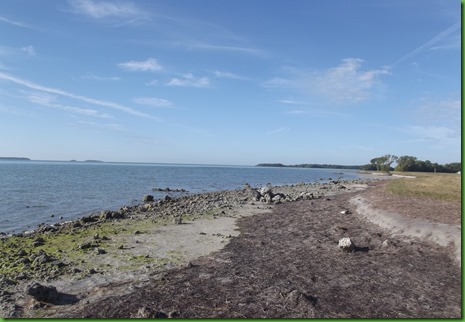
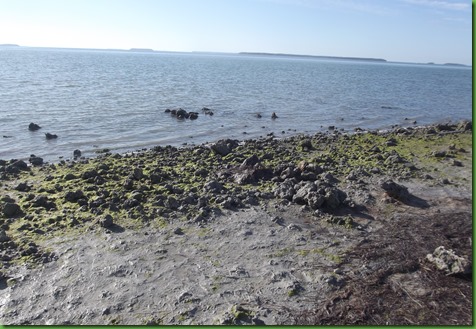













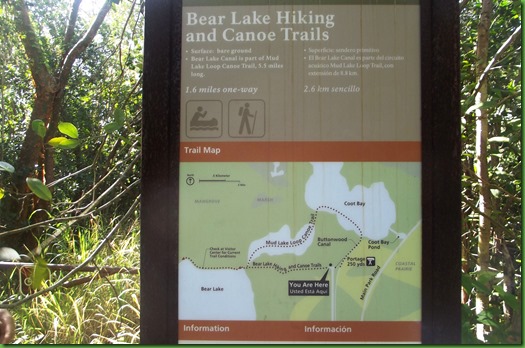




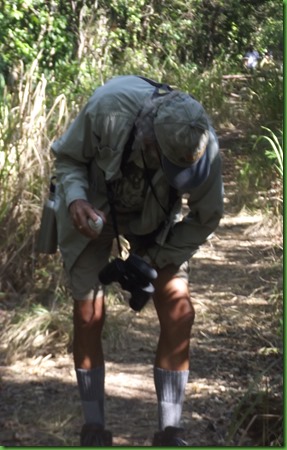







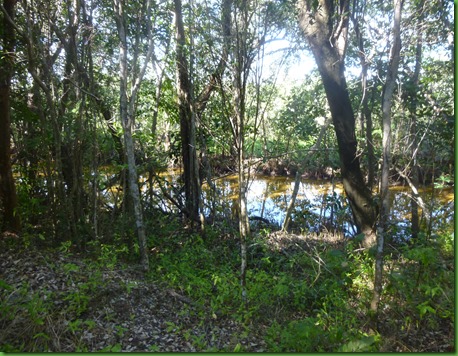


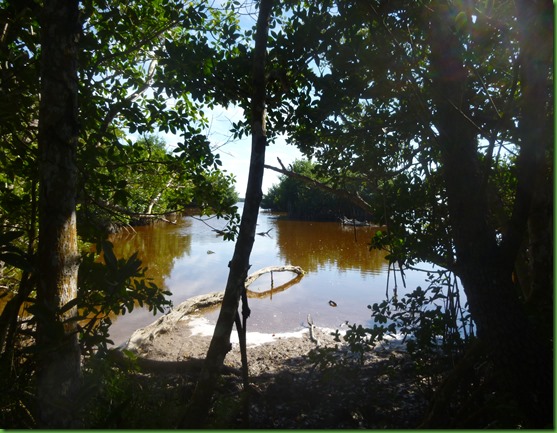















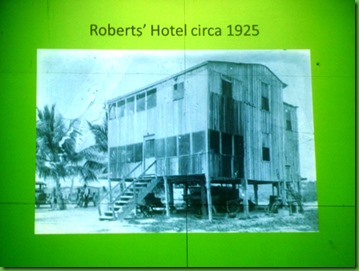




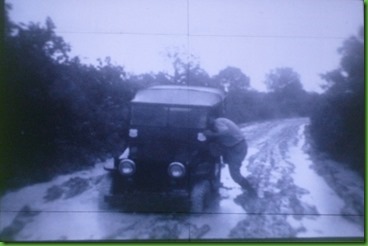



Just make sure you don't get too much of that wonderful Florida sunshine and turn into a Gumbo Limbo Tree's cousin! Too funny, a "Tourist Tree"! :cD
ReplyDeleteRight now we wouldn't mind skeeters too much, as long as the warmth came along with them...
This walk made by itchy ... it's so cold and rainy/snowy here but I really wouldn't trade for the heat and humidity.. that will be forthcoming.. and I hate loathe and despise mosquitoes ... gnats even more BUT the Everglades are a wonder... they really are..
ReplyDeleteSeattle is KILLING Denver... can't believe I'm still watching... I keep thinking Peyton is going to pull of a miracle ... 29-0 man oh man
haaa ... made ME itchy ... by? and pull off not of.. but then you knew that...
DeleteI don't think I could deal with the mosquitos! You saw a lot and took lots of pictures in spite of them.
ReplyDeleteLove the Gumbo Limbo Trees!
ReplyDeleteOh, dear, I was itching just reading this post. I was sure I could feel the mosquitoes!!! Yuck!!!
I know crocodiles only occur down there, but are they natural or a long ago introduced species?
ReplyDeleteThe only way I know of telling the difference between a male and female osprey is to really get up close and personal with them. One will have cojones (cloacal protuberance) and the other won't. :)
I thought of you today while I was looking at the fantastic seashell display at the Museum of the Gulf Coast.
Hi Judy so nice to hear you were thinking of me. I know I'd love to see that seashell display. The crocodiles are actually natural. They have come up from the more southern tropics but only come this far north. I'm not sure how far north they are in the park but they are in the waterways in Flamingo although the only place you can reliably see them is at the marina.
DeleteFrom what I have read, the female osprey develops a brown necklace on her chest; the male doesn't. Also, if there is a chick in the nest, it's a good bet that the adult with it is the female (esp. if there is only one) as until the chick is 6 weeks old, the male does all the hunting.
ReplyDeleteWow, lots of interesting info. Strange how there are more mosquitoes during the day than the evening, it was the opposite last summer on South Padre Island.
ReplyDeleteHi Teri thanks for your comment. South Padre is a place I'd like to visit although maybe not in summer. The mosquitoes are usually only at dawn and sunset but this year with all the rain they were out on the trails of both the hiking and kayaking variety which are mostly through mangroves all day long. An unusual winter here. Wind keeps them at bay if you are along the shore of the bay or paddling in it.
DeleteWe were so fortunate last year to have the winds that helped keep the mosquitos at bay!! Great information about the history of Everglades NP. Even with mosquitos it is one of my favorite places;o))
ReplyDeleteLoved the info from the ranger talk. And talk about perseverance! To have continued on with the hike despite the heat and mosquitoes - must've been pretty miserable at time. Wonder if there is ever a time you can be in that area and not have to deal with them.
ReplyDeleteWe were here last year Sharon and had very few problems. This has just been such a wet winter that they have been unusually prolific. The luck of the draw I guess.
DeleteI just can't do mosquitoes. Guess we would need to go during a dry season. But I love the tour you are taking us.
ReplyDeleteAgain, great bird pictures! Love the butterfly too! But, the mosquitoes...not so great. Those bastards think they are going to rule the world! At least you got some good exercise. I imagine manatee aren't best friends with crocs so the croc won out for that water spot.
ReplyDeleteSuch an interesting history lesson on the Everglades! But the mosquitoes sound AWFUL. Can't believe it's so hot and humid there and so chilly here in Apalachicola.
ReplyDeleteReally great day.despite the mosquitos - at least for me. I just love this park and enjoy everything we see. Don't care for the mosquitos either since they do itch me since my stem cell transplant. Prior to that they never did.
ReplyDeleteIf that gorgeous butterfly is the state butterfly, then the mozi should be the state bug/bird. Love the bromeliad but what a bear to walk with all those squites. I sure enjoy your way of seeing the Everglades and am glad they have been protected, even with all the water problems.
ReplyDelete